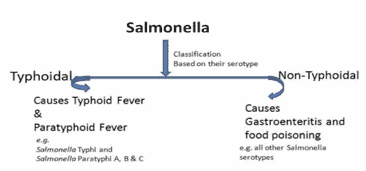Salmonella Typhi Essay Example
-
Emma Lee
- December 17, 2022

Identification and Analysis of Salmonella Typhi
Salmonella Essay: Introduction
It is always curious and surprising to observe how micro creatures such as viruses and bacteria could affect or neutralize comparably giant creatures such as humans and animals. In this sense, one can readily highlight the complexity and irony behind the cellular structure of organisms. In this assignment, Typhoid Fever (a.k.a. Salmonella Typhi) has been selected as the focus of the lab report. The report presents the identification and analysis of Salmonella Typhi. Salmonella Typhi results in the infection of the blood and the intestinal tract, and this situation is known as typhoid fever. The disease is considered common in underdeveloped and developing countries where water treatment systems and infrastructure are not ideal (“Typhoid Fever,” 2019). Nevertheless, S. Typhi is not a negligible case, and it is life-threatening. Any cases related to such microbes should be meticulously and thoroughly analyzed. Headache, dizziness, cough, loss of appetite, high fever, often constipation, and a rash on the trunk are among the symptoms of the Salmonella Typhi. Upon a patient exposed to the bacteria, initial symptoms are seen within a couple of weeks; however, symptoms can be seen up to sixty days or longer.
Body Paragraphs
There are a few causes of the disease before further technical analysis that can create an idea or support the ongoing assumption. Accordingly, a patient might have consumed a drink or food that was prepared by someone with the bacteria, or direct contact with feces of infected people that do not often wash their hands, or ready-to-eat food (sewage contamination), such as shellfish are among the causes of S. Typhi (“Typhoid Fever,” 2019). In this sense, one can readily assume that individuals who have already recovered can be carriers for other people; according to statistics, between %2 and %5 of recovered patients can be carriers of S. Typhi (“Typhoid Fever,” 2019).

Figure 1. Salmonella Class.
For the diagnosis of Typhoid fever, blood culture is the mainstay. Despite not definitive, presence of symptoms and characteristics and presence of certain antibodies suggest the typhoid fever. Blood, bone marrow aspirate, stools (especially for carriers), and duodenal aspirate can be among the samples. Also, blood should be taken prior to giving any antimicrobial therapy (Tankeshwar & Chopra, 2020). Timing is significant, “patients with a history of fever for 7 to 10 days are more likely than others to have a positive blood culture” (Tankeshwar & Chopra, 2020, para. 5). The volume should be 10-15 ml from adults and school children, and merely 2-4 ml from preschool children and toddlers (Tankeshwar & Chopra, 2020), and one should not neglect that fact that “children have a higher level of bacteremia than adults (Tankeshwar & Chopra, 2020, para. 11). Also, during transport, one should not refrigerate the sample or keep in the cold.
For reporting and reading blood culture results for Typhoid fever, inoculated bootles are checked for evidence of growth, gas formation, and turbidity in the 1st, 2nd, 3rd, and 7th days (“Typhoid Fever,” 2019). On the 7th day, though, before discarded as negative, all bottles are subcultured. The incubation should take place in 37 Celsius degree up to a day (18-24 hours). Colony morphology should be noted as long as the growth is observed (Tankeshwar & Chopra, 2020). One should remember that no other bacterial pathogen is observable in blood except S.Typhi. There are two characteristics of colonies: blood agar (S.typhi and S. paratyphi produce non-hemolytic smooth white colonies) and MacConkey agar (producing lactose non-fermenting smooth colonies) (Tankeshwar & Chopra, 2020, para. 14).

Table 1. Antigen composition

Source: Tankeshwar & Chopra, 2020.
The antigenic compositions of microbe causing typhoid fever are shown in Table 1. “Isolated Salmonellae can be characterized by detecting the presence of their somatic (O) and flagellar (H) antigens using specific antiserum,” and accordingly, “specific O antigen for S.typhi is O9, O2 for S. paratyphi A, O4 for S. paratyphi B and O6/7 for S.paratyphi C” (Tankeshwar & Chopra, 2020). As for treatment, antibiotics are highly recommended because without antibiotics, the mortality rate might increase up to %20 percent, and symptoms can last for years. However, doctors should decide which treatment will be effective. In any case, antibiotics will help eradicate bacteria from the patient’s system so that he/she does not pass the bacteria on other individuals. Although the complication has an increased rate of mortality, antibiotics treatment drastically reduces the probability of death or serious conditions.
Salmonella Typhi Essay: Conclusion
In conclusion, the paper has concentrated on Typhoid Fever (a.k.a. Salmonella Typhi). It has been selected as the focus of the lab report. The report has presented the identification and analysis of Salmonella Typhi. Salmonella Typhi leads to the infection of the blood and the intestinal tract, and this situation is known as typhoid fever. After all, antibiotics can be considered as the utmost solution depending on the patient and the nature of the disease.
References
Tankeshwar, A., & Chopra, V. (2020, April 5). Salmonella: Properties, Disease, and Laboratory diagnosis. Retrieved May 14, 2020, from https://microbeonline.com/salmonella-disease-properties-pathogenesis-and-laboratory-diagnosis/
Typhoid Fever (Salmonella Typhi). (2019). Retrieved May 14, 2020, from http://bccdc.ca/health-info/diseases-conditions/typhoid-fever-salmonella-typhi
Contents
Recently on Tamara Blog

Essay on Animal Farm by Orwell – Free Essay Samples
“Animal Farm” by George Orwell is a literary masterpiece that tells the story of a group of farm animals who rebel against their human farmer and establish a socialist community based on the principles of equality and mutual respect (Orwell, 1945). However, over time, the pigs who lead the revolution gradually become corrupted by power and begin to oppress and exploit the other animals, ultimately turning the farm into a totalitarian state.

Essay on Cyberbullying – Free Essay Samples
Bullying is an aggressive behavior that is intentional and repeated, aimed at causing harm or discomfort to a person, and often takes place in social environments such as schools, workplaces, and online platforms. Cyberbullying is a relatively new form of bullying that has emerged with the widespread use of technology and the internet. Cyberbullying refers to bullying behaviors that occur online or through electronic means, such as social media, text messages, and emails.

Essay on Nature vs. Nurture – Free Essay Samples
The debate over nature versus nurture has been a longstanding topic of interest among psychologists and other scholars. The two concepts, nature and nurture, are frequently used to explain human development and behavior.

Lord of the Flies Essay – Free Essay Samples
Veterans have played a critical role in the history of the United States, serving their country in times of war and peace. Despite their sacrifices, many veterans face significant challenges, including physical and mental health issues, homelessness, and unemployment.

Why Veterans Are Important – Free Essay Samples
Veterans have played a critical role in the history of the United States, serving their country in times of war and peace. Despite their sacrifices, many veterans face significant challenges, including physical and mental health issues, homelessness, and unemployment.

American Dream Essay – Free Essay Samples
The American Dream has been a central concept in American culture for decades, representing the idea that anyone, regardless of their background, can achieve success and prosperity through hard work and determination. The concept of the American Dream is rooted in the country’s history and has been promoted in various ways, from the founding fathers’ beliefs to the post-World War II era.